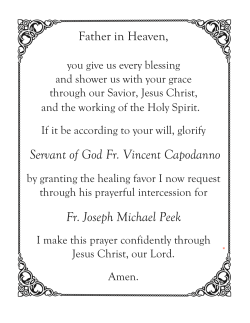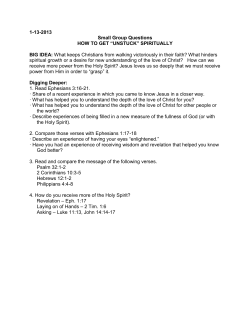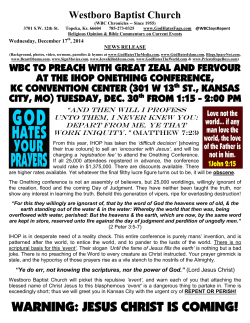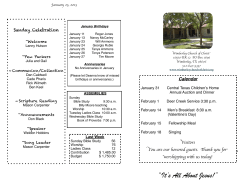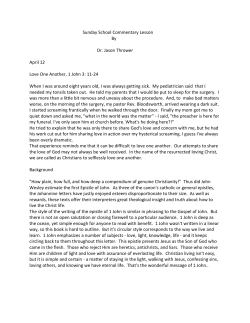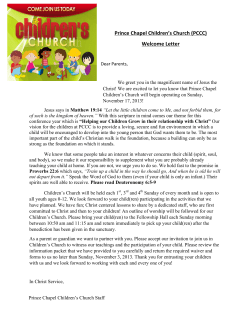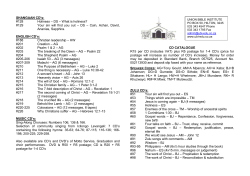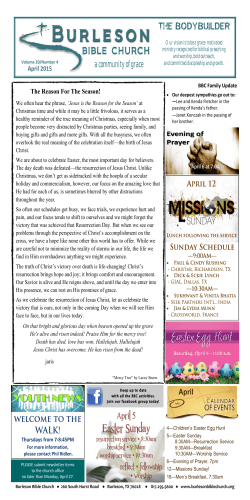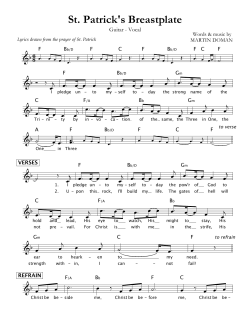
The Last Word on Christ Daniel 7:13-14 and Revelation 1:12
1 The Last Word on Christ Daniel 7:13-14 and Revelation 1:12-20 April 26, 2015 M. Michelle Fincher Calvary Presbyterian Church As we saw last week, in the opening words of the Apocalypse, John tells us that he is recording “the revelation of Jesus Christ.” By that John means that the revelation is about Jesus Christ and it also comes by means of Jesus Christ. Another way to say it is that Jesus is both the content of the revelation and the agent of the revelation. Jesus Christ is the way in which God reveals himself to us; Jesus Christ is also God himself being revealed to us. I bring this up again this week because it is imperative to understand that John’s vision is not primarily information about the bad world we live in, or a report on the first century church under persecution, though it does speak to both of those realities. But, first and foremost, the Apocalypse is a proclamation by and about Jesus Christ. Everything in the vision regarding future and past are introduced only insofar as they are useful in unveiling to us the person and work of Jesus Christ. Some of the kids’ shows I used to watch on television used a little bouncing ball to hop from word to word of a song that was being sung. Kids were told to “follow the bouncing ball” to learn the song. In the book of Revelation, Jesus Christ is our bouncing ball. The imagery and symbolism can easily distract us, but remembering that it all has one centering purpose—the purpose of Jesus Christ—will help keep us focused. The task of keeping Christ at the center is continually difficult, even in the church. Other things try to elbow their way to the front: the golden rule, the doctrine of atonement, the Ten Commandments, Paul’s teaching on justification, the theology of the Trinity. It’s not that we’re likely to lose Christ altogether—too much has been said, too much preached, too much written for anyone to forget that he is one to be reckoned with. But, it is very easy to remove him from the center, to water down his call to follow him, to make him an object of intellectual pursuit rather than a lord that deserves our obedience. But, John’s Revelation gets the last word and the last word is always Christ: Christ the center and Christ at the center. How does John present Christ so that we will recognize and hold on to this centrality? A shepherd Christ tending his flock? A benevolent Christ holding little children in his arms? A tragic Christ nailed to the cross? A compassionate Christ 2 touching the leper? A Socratic Christ in sharp-edged dialogue with the Pharisees? The possibilities are numerous. What we actually get is something quite unexpected. John is commanded by the trumpet voice to begin his writing by describing a vision of Christ “like a Son of Man.” The phrase “son of man” originates in the vision of Daniel, as we heard earlier. This Son of Man is a commanding, redeeming, glorious figure. He is not, as Tom Howard once put it, “a pale Galilean, but a towering and furious figure who will not be managed.” The phrase evokes a picture of someone who fills the cosmos with creative light and energy, who reclaims all the splendor of Adam and in the process reclaims all Adam’s descendants, restoring them to their glorious original identities as people made in the image of God. This is not, of course, the first time we see this title ascribed to Jesus. It is used numerous times throughout the gospels and not infrequently it is Jesus himself who designates himself as the Son of Man. This was bound to produce puzzled consternation: this ordinary, itinerant rabbi the Son of Man? It just didn’t fit. Where were the flashes of lightning and the flowing robes? This was a title that aroused expectations of redemption, and Jesus’ refusal to call down legions of angels to establish his power dashed those expectations. Yet he continued to insist on the title. Even by harnessing our best imaginative powers it is difficult to capture the incongruity of a person who claims to be the Son of Man hanging pierced and bleeding on a cross. It’s offensive that the Son of Man has dinner with a prostitute, stops off for lunch with a tax-collector, wastes time blessing children when there were Roman soldiers to be chased from the land; that he heals unimportant nobodies and ignores high-achieving Pharisees and influential Sadducees. Jesus juxtaposed the most glorious title available with the most menial of lifestyles. He talked like a king and acted like a slave. He preached with utmost authority and lived like a vagabond. Jesus relentlessly held both realities together: he was, in fact, Son of Man, the one “given dominion and glory and kingdom.” He was, also, in fact completely at home in the ordinary, the mundane and common, the everyday. He did not give an inch in either direction: he was very God and very man. The task of faith, for those who agreed to be his disciples, was to accept the literal truth of the title Son of Man under such seemingly incongruous conditions, to immerse themselves in cross-bearing, self-denial, suffering, and death at the 3 same time they believed that everything they did and spoke was part of the victorious rule of God’s kingdom. They were challenged to see eternal glories channeled into the ordinary, to experience the everyday made splendid with grace, healing, peace and blessing. I think we have the same challenge today. While there is always the danger in the life of faith of escapist dreaming and fanatical irresponsibility, the bigger risk has more often been of having a meager, diminished hope. Our greatest threat is that the largeness and mystery of Christ may be lost and religion become flat and insipid. Faith in such a condition dries up; it’s hollow. It fails to stir either the imagination or the heart. What better or more needful time to reintroduce the apocalyptic splendor of Daniel’s vision of the Son of Man. The vision begins in vs. 13 with a description of his clothing: “a long robe with a golden sash across his chest.” Before we know what the Son of Man looks like, we know what he does: his clothing defines his role. He wears the vestments prescribed for Aaron in his priestly work. It turns out the Son of Man is a priest. In the line of Aaron’s priesthood, a priest presents God to the people and he also presents the people to God. He brings together the divine and the human. Priests do not protect God’s holiness from human sinfulness nor do they protect human weakness from divine judgment. Instead, the priest opens up means of access that have been closed by fear or guilt or ignorance. A priest mediates between God and humanity, as much on God’s side as ours; as much on our side as God’s. So, if the Son of Man does the work of a priest, there is much to be in awe of but nothing to fear, much to repent of but nothing to despair: his mediation results in loving fellowship and gracious forgiveness. After the clothing, the head and eyes are the first things we look at in a person. If the clothes present a role, the head and eyes declare character. Are the role and the character congruent? Does the person fit the call? The head and the eyes of the Son of Man show him to be both pure and purifying. His white head and hair recall to us the prophet’s promise, “Your sins are like scarlet, they shall be as white as snow….they shall become white like wool.” A host of biblical images leap to mind as we gaze on his fire-flaming eyes: the pillar of fire, burning bush, altar fires, fiery furnace. Fire penetrates and transforms. Holiness gets inside us and when it gets inside us it changes us. 4 Christ’s gaze penetrates and purifies. He doesn’t look at us, he looks into us. We are not a spectacle to Christ. Instead, he invades us. Next John moves from his head to his feet. “His feet were like burnished bronze, refined as in a furnace,” we’re told in vs. 15. Once again John’s imagery links us directly to the book of Daniel and the great image that Nebuchadnezzar dreamed and Daniel interpreted. That image had a head of fine gold, a torso of silver, belly and thighs of bronze, legs of iron, and feet that were a mixture of iron and clay. The iron and clay did not make a good bond. The image itself was magnificent, constructed of precious and strong metals, but it was set on a base that was flawed. When struck by a rolling rock, it fell apart. In contrast, the Son of Man’s feet in John’s vision are made of solid bronze. Bronze is a combination of iron and copper. Iron is strong, but it rusts. Copper won’t rust but it is pliable. When you combine the two you get the best quality of each, the strength of the iron and the endurance of the copper. The point is clear: the succession of the kingdoms of this earth, no matter how impressive and powerful, is set on a base that is flawed which dooms them to eventually crumble. Christ’s kingdom is set on a base that is as strong as its superstructure is magnificent. He is central. His kingdom alone will endure. John moves on to describe the Son of Man’s voice as like “the sound of many waters.” It is a commanding, awesome sound, one that is intended to elicit praise and worship. A gossipy, tepid, indifferent response to “the sound of many waters” is unthinkable. When John first heard the voice back in vs. 10, he immediately turned to see who was speaking, and what first caught his eye was a circle of seven lamps. Now in vs. 16, John sees seven stars in the right hand of the Son of Man. These objects, lamps and stars represent the churches and angels. Both are meant to give light to the world but they pale before the radiant face that shines like the sun, the One who is The True Light of the world. Again and again the centrality and supremacy of Christ is upheld. Finally, John says, “a sharp, two-edged sword” comes from the mouth of the Son of Man. Our thoughts race at once to the writer of Hebrews who tells us that the “word of God is living and active, sharper than any two-edged sword, piercing to the division of soul and spirit, of joints and marrow, and discerning the thoughts and intentions of the heart.” ( 4:12) Christ does not come with a sword but with the word, which acts like a sword. God’s will is articulated sharply and penetratingly 5 as it proceeds from Christ’s mouth. These words conquer. They cut through willful resistance, divide good from evil, overcome rebellion, and establish righteousness. The power that the world acknowledges comes out of implements of violence. The power that the church respects comes from the mouth of Christ. John is overcome by what he has seen and heard and he does what I think any of us would do: he falls at the feet of the Son of Man in adoration and worship. Christ speaks both to calm John’s fear and to offer yet one more selfdisclosure using the “I am” language so prominent in the Gospel of John. Here he announces, “I am the first and the last ,” the One who spans all history and all time. “I am the living one.” He is the risen, exalted Christ who having been crucified, now rules over all that is—even over the power of death. Visions, if they are truly visions and not just wishful dreams, make things happen. John the exile is now John the empowered, and the vision did it. From rocky Patmos he is lifted to the realm of the Spirit and given a vision of Christ. He is returned to earth and made a pastor again, but this time a pastor with power. Rome shut John away so his churches would neither see nor hear him. The Spirit filled his eyes with sights and his mouth with speech that have given sight and direction to Christians ever since. When we, with John, catch a glimpse of the reality of the Son of Man—his power, his absolute authority, his unassailable word, all in concert with his compassion and love for the lowly, the broken, the rebellious, or in other words, his love for us—then we, too, come to see a plan in history. We begin to grasp what is really happening in our world, how we fit in, and where all of this is leading. The vision allows John to perceive a grand design on the beautiful, perfect side of the tapestry which begins to make sense of the tangle of crossed threads, broken strands, unruly knots and loose ends on the back side we are most familiar with, the side we live day by day. The vision invites us to see our lives and our story as integrally connected to the bigger story of God. And, in those places where we still can’t quite make out how it all fits together, we’re invited to keep Jesus front and center and trust him. Let us pray…..
© Copyright 2025
